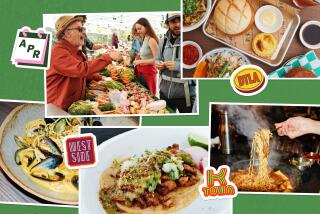Freeze’s lasting damage
THOUGH last weekend’s frigid temperatures are easing, their results will be felt at farmers markets and groceries for months. And while citrus and avocado growers were the hardest hit, many other fruit and vegetable crops were devastated as well.
Farmers from every agricultural region in Southern and Central California -- from north San Diego County to the San Joaquin Valley and east to Temecula -- report that this freeze was one of the most devastating to crops in the last 20 years, as icy Arctic air smothered the state for several days in a row. Growers say they’ve lost 50% or more of crops including strawberries; vegetables such as peas and celery; and lettuces, herbs and other tender greens. As a result, consumers can expect to see shortages of these for at least the next several weeks and maybe beyond.
Indeed, because the freeze affected some of the greenhouses where tomato and other vegetable plants are started, the effects of this freeze could ripple out through the early summer.
Dennis Peitso of Maggie’s Farm says he isn’t even going to try to get his lettuce greens to the farmers market for at least a month. “Man, the sky just fell,” he says. “It’s hard to tell how bad it is because the wind is still blowing, but we may have lost everything, the whole enchilada, 100%. If everything works just right, we may only lose 50%, but that’s the best I can hope for.”
Jerry Rutiz, one of the most popular vegetable growers at the Santa Monica Farmers Market, says he isn’t going to the market today. Though he plans to be back next week, he probably won’t be able to offer some of his best-selling items, such as peas, for another month.
“Those are just completely gone,” he says. “They had come on really early because the weather had been so warm, and we had a beautiful crop we had just started picking.”
Molly Gean, whose family’s Harry’s Berries farm grows strawberries and some vegetables near Oxnard, says they lost all the fruit that was on the plants, but that the plants themselves may pull through. “It doesn’t look like we had any core freezing, but we’ll know next week,” she says.
Perhaps the worst long-term damage was to the summer’s tomato crop, which was just getting started in greenhouses and was wiped out by the freeze.
“We haven’t had one of these in a while, and I guess it had to happen sometime,” Gean says. “I have to be philosophical about it. That’s the farmer’s life. My dad used to say, ‘I don’t need to go to Vegas, because I gamble every day.’ ”
Tutti Frutti Farms’ Chris Cadwell says that on part of his property along the Santa Ynez River near Lompoc, temperatures got as low as 15 degrees. “Even the broccoli and cauliflower froze,” he says. He estimates that he probably lost 70% of those vegetables and all of his lettuces. “But I’ve still got carrots, parsnips, leeks and cabbage that survived. I’m sure a lot of people had it worse than I did.”
By far the worst damage was suffered by citrus and avocado growers, and lemons, oranges, tangerines and grapefruit are likely to be in short supply for the rest of the winter.
Because damage can be hard to detect, growers won’t know for several days -- or even weeks -- exactly how badly they were hit. In the worst case, young trees, which are especially susceptible to a freeze, could be killed outright.
“I won’t know until Thursday at the earliest, but I’d guess I’ve lost about half of my citrus harvest,” says Richard Burkart, who farms citrus and stone fruit in Dinuba in the Central Valley. “I don’t see how it could be any better than that.
“The good news is that this has happened before, in ’98 and in ‘90, and I think people are more prepared for it now,” Burkart says. “I noticed that a lot of the farmers around me had been really working picking everything they could before the freeze. All around me I was seeing lights out in the fields until really late.”
But even in the best-case scenario, the damage was severe.
“It got down to 19 in my orchard; it was just sheets of ice,” says Mike Agnew of Agnew’s Sweet Acres in Lindsay. He says he was able to pick 13,000 pounds of fruit before the freeze, but that may be all he can save out of the more than 600,000 he normally harvests every year.
“They used to say these were once-in-a-lifetime freezes. I’ve been farming 19 years and had three of them. So I guess I’ve been reincarnated twice and didn’t know it.”
*
More to Read
Eat your way across L.A.
Get our weekly Tasting Notes newsletter for reviews, news and more.
You may occasionally receive promotional content from the Los Angeles Times.







